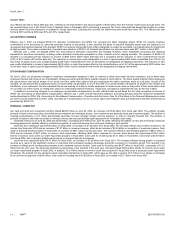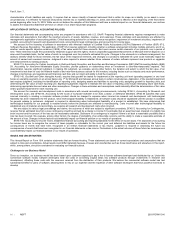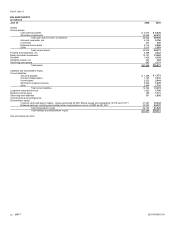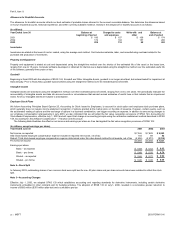Microsoft 2003 Annual Report Download - page 36
Download and view the complete annual report
Please find page 36 of the 2003 Microsoft annual report below. You can navigate through the pages in the report by either clicking on the pages listed below, or by using the keyword search tool below to find specific information within the annual report.Part II, Item 8
MSFT 2003 FORM 10-K
23 /
NOTES TO FINANCIAL STATEMENTS
Note 1—Accounting Policies
Accounting Principles
The financial statements and accompanying notes are prepared in accordance with accounting principles generally accepted in the United States of America.
Principles of Consolidation
The financial statements include the accounts of Microsoft Corporation and its subsidiaries (Microsoft). Intercompany transactions and balances have been
eliminated. Equity investments in which we own at least 20% of the voting securities are accounted for using the equity method, except for investments in which
the Company is not able to exercise significant influence over the investee, in which case, the cost method of accounting is used.
Estimates and Assumptions
Preparing financial statements requires management to make estimates and assumptions that affect the reported amounts of assets, liabilities, revenue, and
expenses. Examples include estimates of loss contingencies and product life cycles, and assumptions such as the elements comprising a software arrangement,
including the distinction between upgrade/enhancements and new products; when technological feasibility is achieved for our products; the potential outcome of
future tax consequences of events that have been recognized in our financial statements or tax returns; and determining when investment impairments are other-
than-temporary. Actual results and outcomes may differ from management’s estimates and assumptions.
Foreign Currencies
Assets and liabilities recorded in foreign currencies are translated at the exchange rate on the balance sheet date. Revenue and expenses are translated at
average rates of exchange prevailing during the year. Translation adjustments resulting from this process are charged or credited to other comprehensive income
(OCI).
Revenue Recognition
Revenue for retail packaged products, products licensed to original equipment manufacturers (OEMs), and perpetual licenses for current products under our Open
and Select volume licensing programs is generally recognized as products are shipped, with a portion of the revenue recorded as unearned due to undelivered
elements including, in some cases, free post-delivery telephone support and the right to receive unspecified upgrades/enhancements of Microsoft Internet Explorer
on a when-and-if-available basis. The amount of revenue allocated to undelivered elements is based on the sales price of those elements when sold separately
(vendor-specific objective evidence) using the residual method. Under the residual method, the total fair value of the undelivered elements, as indicated by vendor-
specific objective evidence, is recorded as unearned, and the difference between the total arrangement fee and the amount recorded as unearned for the
undelivered elements is recognized as revenue related to delivered elements. Unearned revenue due to undelivered elements is recognized ratably on a straight-
line basis over the related product’s life cycle, which is currently estimated at three and a half years for Windows operating systems and two years for desktop
applications (primarily Office).
Revenue from multi-year licensing arrangements are accounted for as subscriptions, with billings recorded as unearned revenue and recognized as revenue
ratably over the billing coverage period. Certain multi-year licensing arrangements include rights to receive future versions of software product on a when-and-if-
available basis under Open and Select volume licensing programs (currently named Software Assurance and, previously, Upgrade Advantage). In addition, other
multi-year licensing arrangements include a perpetual license for current products combined with rights to receive future versions of software products on a when-
and-if-available basis under Open, Select, and Enterprise Agreement volume licensing programs. MSN Internet Access subscriptions, Microsoft bCentral
subscriptions, and Microsoft Developer Network subscriptions are also accounted for as subscriptions.
Revenue related to our Xbox game console is recognized upon shipment of the product to retailers. Online advertising revenue is recognized as
advertisements are displayed. Consulting services revenue is recognized as services are rendered, generally based on the negotiated hourly rate in the consulting
arrangement and the number of hours worked during the period.
Costs related to insignificant obligations, which include telephone support for developer tools software, PC games, computer hardware, and Xbox, are accrued
when the related revenue is recognized. Provisions are recorded for estimated returns, concessions, and bad debts.
Cost of Revenue
Cost of revenue includes manufacturing and distribution costs for products and programs sold, operation costs related to product support service centers and
product distribution centers, costs incurred to support and maintain Internet-based products and services, and costs associated with the delivery of consulting
services.
Research and Development
Research and development expenses include payroll, employee benefits, and other headcount-related costs associated with product development. Technological
feasibility for our software products is reached shortly before the products are released to manufacturing. Costs incurred after technological feasibility is
established are not material, and accordingly, we expense all research and development costs when incurred.
Sales and Marketing
Sales and marketing expenses include payroll, employee benefits, and other headcount-related costs as well as expenses related to advertising, promotions,
tradeshows, seminars, and other programs. Advertising costs are expensed as incurred. Advertising expense was $1.02 billion in 2001, $1.13 billion in 2002, and
$1.06 billion in 2003.
























